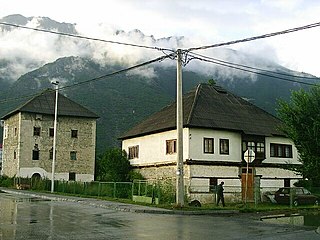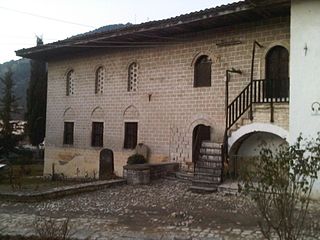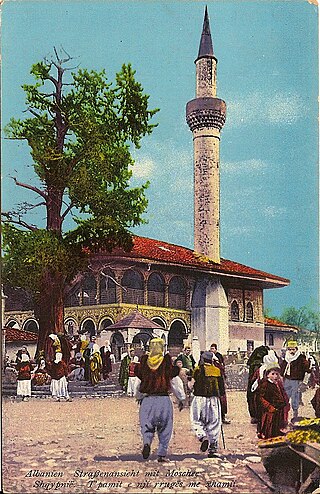
Ulcinj is a town in Coastal region of Montenegro and the capital of Ulcinj Municipality. It has an urban population of 11,488.

Gusinje is a small town in Montenegro in the northern region. According to the 2011 census, the town has a population of 1,673 and is the administrative center of Gusinje Municipality.

Ulcinj Municipality is the southernmost municipality of Montenegro, bordered by Albania to the east, Bar Municipality to the north and Adriatic Sea to the south and the west. It has an area of 255 km², and a population of 19,921 as of the 2011 census. Its seat is the town of Ulcinj.

Islam in Montenegro refers to adherents, communities and religious institutions of Islam in Montenegro. It is the second largest religion in the country, after Christianity. According to the 2011 census, Montenegro's 118,477 Muslims make up 20% of the total population. Montenegro's Muslims belong mostly to the Sunni branch. According to the estimate by the Pew Research Center, Muslims have a population of 130,000 (20.3%) as of 2020.

The Bazaar Mosque, also known as Memi Bey Mosque, is a mosque located in Gjirokastër, Albania.

The King Mosque, also known as the Sultan's Mosque or Sultan Bayezid Mosque, is a mosque and a Cultural Monument in Berat City, Berat County, Albania.

The King Mosque or Sultan Bayezid Mosque is a historical Ottoman-era mosque within the Ottoman Elbasan Castle in the town of Elbasan, Albania.

The Sailors' Mosque is an important landmark in Ulcinj, Montenegro that once served as a lighthouse.

Pasha's Mosque is one of six mosques in the city of Ulcinj, in Montenegro.

Ulcinj Old Town or Ulcinj Castle is an ancient castle and neighborhood in Ulcinj, Montenegro. Today mostly inhabited by Albanians, it was built by the Illyrians on a small peninsula at the right side of the Pristan Gulf, which is part of the Adriatic Sea. Today, oldest remains are the Cyclopean Wall. The castle has been restored many times since it was first built although major changes were made by the Byzantinians, Serbs, Venetians, and Ottomans. The modern city of Ulcinj was built outside of this castle.

The Church-Mosque of Ulcinj, also called Imperial Mosque, Halil Skura Mosque, Kalaja Mosque or Church of St. Maria is a former church and mosque located in Ulcinj, Montenegro.

The Lami Mosque is one of the six mosques in Ulcinj, Montenegro.
The Kryepazari Mosque, also called Majapazari Mosque is one of the six mosques in Ulcinj. It was built by Nuradin-Beg from Ulcinj in 1749. It was destroyed in the earthquake in 1979, and 16 years later it was renewed by the donations of the local people. The Friday Khutbah is given in Arabic and Albanian. To the complex of this mosque also belong the main office of the Islamic religious community of Ulcinj, a library and a kindergarten.
The Bregu Mosque is one of the six mosques in Ulcinj, Montenegro, and it is located in neighbourhood Meraja. It was built by captain Ahmet Gjyli from Ulcinj in 1783, near his own house. It was significantly damaged in the earthquake in 1979 and in 1986 was reconstructed. The Friday Khutbah is given in Arabic and Albanian.

The Clock Tower of Ulcinj, was built in Ulcinj, Montenegro in 1754 during the Ottoman Empire's rule over the city, with the help of donations made by the citizens of Ulcinj. The name comes from the Turkish Saat Kulesi which literally means "Clock Tower" in English.

Museum of Local History in Ulcinj or simply Museum of Ulcinj is a local museum located in Kalaja, part of Ulcinj, Montenegro.

Gusinje Municipality is a municipality in northern Montenegro. It is located in the upper Lim valley at an elevation of about 1,000 m (3,000 ft). It was created in 2014, when it split from Plav Municipality. Its center is the small town of Gusinje, and its biggest village in terms of territory is Vusanje. Two of Montenegro's highest mountains overlook Gusinje: Zla Kolata and Visitor. Many of Gusinje's settlements are historically linked with the Albanian Kelmendi tribe (fis). The village of Gusinje developed into a town the 17th century around a fortress built by the Ottomans to contain the Kelmendi. In the 19th century, Gusinje was a developing regional market center. It was engulfed in 1879–1880 in a struggle between the Principality of Montenegro that wanted to annex it and the League of Prizren that opposed it. After the Balkan Wars, Gusinje became part of Montenegro and in 1919 part of Yugoslavia. Today, it is part of Montenegro since its declaration of independence in 2006.

The Fatih Sultan Mehmet Mosque, also known as the St. Stephen's Cathedral of Shkodër in Rozafa is a 13th-century building within the Rozafa Castle near Shkodër, Albania.

The Mosque of Mahmud Agha Kokonozi or New Bazaar Mosque is a mosque in Tirana, Albania. It is an Ottoman-era mosque built in 1750 and one of the few mosques that survived the communist dictatorship under the Hoxhaist regime.

The Old Mosque or Sulejman Pasha mosque was the founding mosque of the Albanian capital Tirana. The city developed around the mosque, which was founded by the Ottoman Albanian Pasha Sulejman Bargjini along with a hammam and a bakery. In the mid of the 20th century, all of it was razed to make place for the Communist-era Unknown Soldier statue.




















